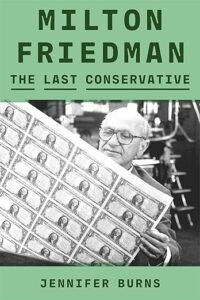Milton Friedman's Many Battles
By Arnold Kling


- Characteristically, Friedman had a contrarian take on the Washington consensus. Ironically, the turn toward markets gave new life to the classic institutions of the postwar managed economy, namely the World Bank and the International Monetary Fund (IMF). No longer working to stabilize a gold-backed currency, the two international organizations offered loans to emerging economies—typically conditional upon implementing some version of the Washington consensus. This was a primary mechanism by which the consensus spread, the carrot that lured nations into making change. But to Friedman, their continued existence was a textbook case of bureaucratic overreach.
- Jennifer Burns, Milton Friedman: The Last Conservative.1 (pp. 445-446).
Keynes and Black, as well as Joseph Schumpeter and Alfred O. Hirschman, did their biographers the favor of living colorful lives. Skidelsky and Mehrling are able to extract interesting connections between their subjects’ personal lives and their scholarly contributions. For example, Keynes’ intense hatred of the ethic of saving is plausibly due to his closeness to Lytton Strachey and other Cambridge Apostles and Bloomsbury Group members who rebelled against Victorian morality in general.
Friedman was quite tame by comparison. Burns has to struggle to tease out anything interesting relating Friedman the person to Friedman the intellectual.
In an interview with Politico in April of 2020, then candidate Joseph Biden declared “Milton Friedman isn’t running the show any more.” Within the economics profession, Friedman came closest to running the show in the early 1970s. His influence on economic policy probably peaked about 15 years later, with the spread of the “Washington Consensus” in favor of limited government and low inflation. But Friedman seemed never satisfied with his victories, seeing them as incomplete. As his criticism of the Washington Consensus shows, he did not see himself as running the show even when others did.
The biggest battle Friedman fought was over monetary policy. He wanted to achieve three things.
-
- (1) The central bank (The Fed in the United States) should take responsibility to curb inflation.
-
- (2) To do this, the central bank should follow a strict rule concerning growth in the money supply, rather than make discretionary changes based on other economic indicators.
-
- (3) In particular, the central bank should try for steady, slow growth in the measure of the money supply known as M2.
On (1), Friedman won a decisive victory. But he lost completely on (2) and (3). Even Paul Volcker, the Fed chairman whose adoption of (1) is considered the classic central banking achievement, did not go along with (2) and (3). Burns writes,
- Although Volcker called his approach “practical monetarism,” he always kept Friedman at arm’s length. Like most central bankers, he considered Friedman’s concept of a fixed monetary growth rule too mechanistic and abstract. p. 413.
Friedman succeeded in convincing most economists that policy makers could not drive unemployment below its “natural rate” while achieving a stable rate of inflation. Other battles that went Friedman’s way in the 1970s include the ending of the military draft and the shift from foreign exchange rates fixed by government to flexible exchange rates determined in the market.
When I studied economics as an undergraduate from 1971-1975, one of my teachers, Professor Bernie Saffran, said that Friedman would likely earn the Nobel Prize (which he subsequently did) based on three contributions: the “natural rate” hypothesis, the “permanent income” hypothesis, and the Friedman-Savage explanation for why people gamble and also buy insurance. Burns explains each of these contributions.
Bernie quipped that, “Milton Friedman and Paul Samuelson believe the same price theory. But Friedman applies it to policy.” This was a dig at Samuelson, whose left-wing inclinations often led him to advocate policies that went against basic economic theory.
Bernie also talked to students about the Cowles Controversy, which took place in the early 1950s. The Cowles Foundation inaugurated the development of large computer models of the economy. Prior to that, the National Bureau of Economic Research, under Wesley Mitchell and Arthur Burns, focused on gathering various indicators of economic performance—”Measurement without theory,” as it was derided in a famous essay by Tjalling Koopmans of the Cowles group.
Jennifer Burns writes,
- At seminar after seminar, Friedman pressed the same question: How were models chosen? If the commission wouldn’t clarify its decisions, or publish information on models that hadn’t worked, he would assume they were simply chosen based on the prejudice of the investigator. Repeated week in and week out, the criticism added up to the accusation that the Cowles inquiries were fundamentally corrupt. p. 157.
My first job out of college was working with Cowles-inspired models, but I eventually came to share Friedman’s view of the project.
In Jennifer Burns’ telling, Friedman saw to it that the Cowles group was not welcome at the University of Chicago, and they fled to Yale. But although Friedman was an admirer of Arthur Burns in those days,2 he was more anti-Cowles than pro-NBER. He simply did not trust that the big computer models would yield reliable results. He has been proven correct.
Although Friedman’s methodological criticisms of other economists were on point, he himself seemed to approach empirical work with what Julia Galef would call a soldier mindset rather than a scout mindset. Burns writes,
- It seemed to Friedman’s critics that he was not testing his theory with facts but using facts to confirm his theory. p. 91.
For more on these topics, see
 Robert Chitester on Milton Friedman and Free to Choose. EconTalk.
Robert Chitester on Milton Friedman and Free to Choose. EconTalk. Milton Friedman on Capitalism and Freedom. EconTalk.
Milton Friedman on Capitalism and Freedom. EconTalk.- “Drop Your Intellectual Defenses,” by Arnold Kling. Library of Economics and Liberty, Jun. 7, 2021.
As in the Cowles example, Friedman fought hard on academic personnel matters, often with success. He seems to have been very combative by nature. That is what struck me most about him in reading Burns’ book. Some of the fights have lost their salience, and perhaps Burns could have devoted fewer pages to some of these or even left them out altogether (the Friedman/Meiselman vs. Ando/Modigliani [see Franco Modigliani] argument had no lasting significance, as far as I can tell). But other debates in which Friedman was involved, such as the existence or not of a trade-off between unemployment and inflation, are just as important today.
- Brian Doherty discusses the book Milton Friedman: The Last Conservative, by Jennifer Burns. YouTube, 3/27/24.
Milton Friedman seemed to lean into every battle. Probably that is what enabled him to run his ideas past the gauntlet of prevailing orthodoxy.
Footnotes
[1] Jennifer Burns, Milton Friedman: The Last Conservative. 2023.
[2] I was struck reading this book how often Arthur Burns (presumably no relation to the author) comes across as a villain, both on a personal and professional level.
*Arnold Kling has a Ph.D. in economics from the Massachusetts Institute of Technology. He is the author of several books, including Crisis of Abundance: Rethinking How We Pay for Health Care; Invisible Wealth: The Hidden Story of How Markets Work; Unchecked and Unbalanced: How the Discrepancy Between Knowledge and Power Caused the Financial Crisis and Threatens Democracy; and Specialization and Trade: A Re-introduction to Economics. He contributed to EconLog from January 2003 through August 2012.
Read more of what Arnold Kling’s been reading. For more book reviews and articles by Arnold Kling, see the Archive.
